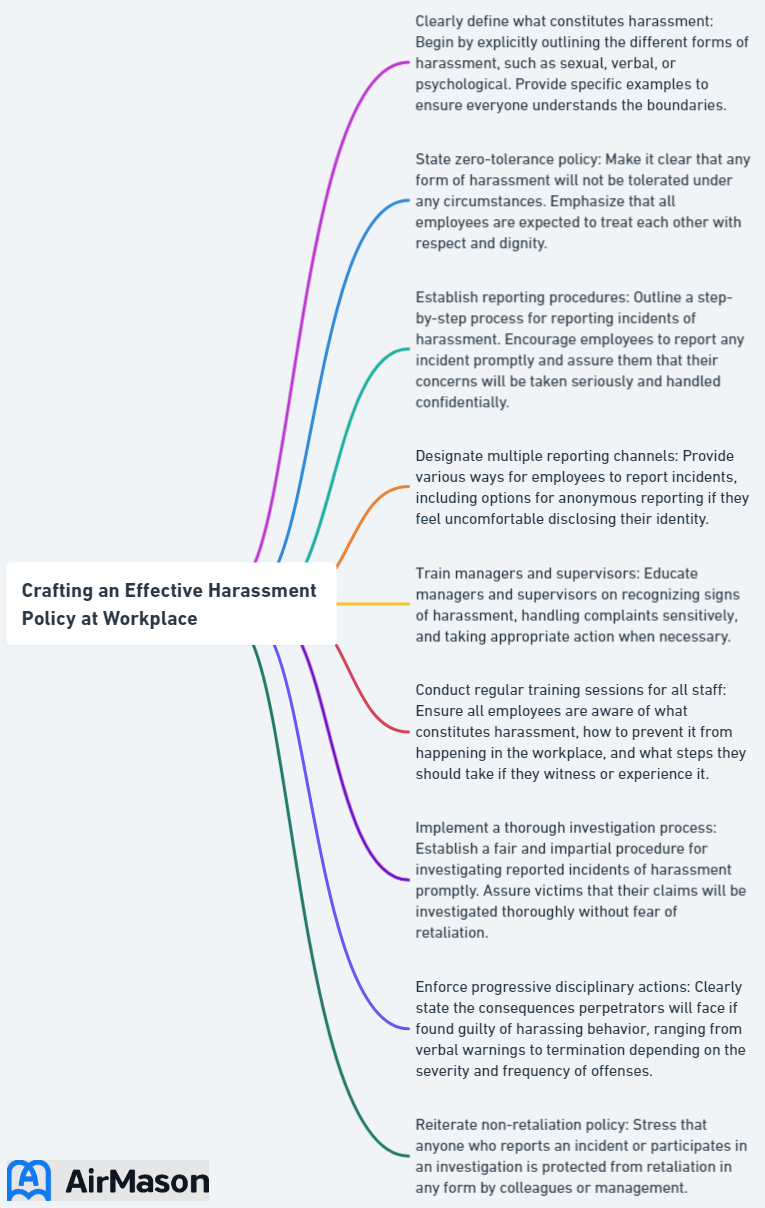
In today’s diverse and dynamic work environment, fostering a culture of respect and inclusivity is paramount. A comprehensive harassment policy at workplace is a crucial tool in maintaining a safe and supportive workplace for all employees. This blog post delves into the essentials of crafting an effective harassment policy, outlining the key components, implementation strategies, and legal protections that contribute to a harassment-free work environment.
Key Takeaways
- Understanding workplace harassment and its types is essential for creating a safe work environment.
- A successful harassment policy should include clear definitions, reporting procedures, investigation & resolution process and legal protections.
- Organizations must foster a culture of respect through training, monitoring & evaluation to ensure employees are protected from any form of harassment.
Understanding Workplace Harassment
Workplace harassment goes beyond the commonly known sexual harassment and can take many forms, including bullying, intimidation, and direct insults. Creating an effective harassment policy requires recognition of different types of harassment and comprehension of the characteristics protected by law. Policies should cover a wide range of behaviors, from offensive work environment conduct to unwanted sexual advances and beyond, ensuring employees feel secure in reporting harassment incidents.
In addition to sexual harassment, workplace harassment can include conduct based on:
- race
- religion
- age
- disability
- any other protected characteristic
An anti harassment policy, also known as a workplace harassment policy, covering all forms of harassment is a key element in maintaining a respectful and inclusive workplace, enabling employees to focus on their tasks without fear of adverse action or discrimination.

Types of Harassment
Types of harassment include sexual harassment, racial harassment, and bullying, among others. These behaviors can create a hostile work environment that interferes with an individual’s work performance and well-being.
Sexual harassment, for instance, is a form of unlawful workplace harassment and workplace discrimination that can manifest in various ways, such as unwelcome conduct of a sexual nature, physical conduct, or demands for sexual favors, and can be related to one’s gender identity. In cases of alleged harassment, it is crucial to address the issue of harassing conduct promptly and effectively.
Providing clear definitions and specific examples of such behaviors within a harassment policy helps employees recognize harassment when it occurs. Addressing all types of harassment is crucial in guaranteeing a workplace free of offensive conduct, where employees can thrive and feel respected.
Protected Characteristics

Protected characteristics are attributes that individuals possess and are legally safeguarded from discrimination and harassment. These characteristics include:
- Age
- Race
- Gender
- Religion
- Sexual orientation
- Disability
among others.
Awareness of these protected characteristics aids in crafting a comprehensive harassment policy, ensuring a safe work environment for all employees. Incorporating these protected characteristics into your policy guarantees that employees are aware of their rights and the company’s commitment to a harassment-free workplace. It also helps prevent potential legal issues that may arise from overlooking or neglecting specific aspects of harassment prevention.
Discriminatory Conduct
Discriminatory conduct refers to any behavior, action, or policy that unfairly treats individuals or groups based on certain characteristics, such as race, gender, ethnicity, religion, or disability. This form of behavior encompasses a wide range of actions, from explicit acts of prejudice to subtle biases that can manifest in institutional structures. It is crucial to recognize and address discriminatory conduct in all its forms to foster inclusivity and equality within society. By identifying and challenging instances of discriminatory conduct, individuals and communities can work towards creating environments that promote fairness and respect for all. Additionally, legal frameworks and policies play a crucial role in combating and preventing discriminatory conduct, providing a foundation for justice and accountability in cases of discrimination. Overall, understanding and confronting discriminatory conduct is essential for building a more just and harmonious society.
The Importance of a Harassment Policy

A well-designed harassment policy aids in maintaining a safe work environment, allowing employees to focus on their tasks without fear of harassment or discrimination. It serves as a clear guideline for employees on what behaviors are unacceptable and outlines the steps that should be taken in case of harassment incidents.
Moreover, a solid harassment policy:
- Protects employees by providing a clear reporting procedure
- Ensures confidentiality and prevents retaliation
- Safeguards the organization from potential legal liabilities that may arise from harassment incidents
- Demonstrates the company’s commitment to a respectful and inclusive work environment.
Key Components of an Effective Harassment Policy

An effective harassment policy should include the following components:
- Clear definitions and examples of what constitutes harassment
- Reporting procedures for employees to follow when they experience or witness harassment
- An investigation and resolution process to address complaints and hold perpetrators accountable
By including these components, organizations can ensure that employees understand their rights and responsibilities, feel encouraged to report incidents, and trust that complaints will be handled fairly and effectively.
Clear Definitions and Examples
Clear definitions and specific examples of harassing behavior are key to ensuring the effectiveness of your harassment policy. Examples of bad behaviors can be seen in many forms. These include:
- Direct insults
- Threats of harm
- Bullying
- Victimization
- Offensive discussions
- Gestures
Addressing these behaviors in your policy helps employees understand what constitutes harassment and ensures they can identify and report incidents accordingly, potentially avoiding disciplinary action.
By providing precise definitions and examples, organizations can prevent misunderstandings that may arise from ambiguous language and create a strong foundation for a harassment-free workplace. Employees can then confidently identify and report incidents, fostering a culture of respect and inclusivity.
Reporting Procedures
A transparent and accessible reporting procedure encourages employees to report harassment incidents when they occur. The procedure should ensure confidentiality and protection from retaliation for both the complainant and the accused. Providing multiple avenues for reporting, such as a designated person, hotline, or email, can make employees feel more comfortable coming forward with their complaints.
Swift action should be taken to address harassment complaints, demonstrating the organization’s commitment to a harassment-free workplace and fostering trust among employees. Effective reporting procedures not only protect employees but also help organizations identify and address issues promptly, preventing escalation and potential legal ramifications.
Investigation and Resolution Process
A thorough investigation and resolution process ensures fair and effective addressing of harassment complaints. This process should be timely, impartial, and protect the rights of all parties involved. Investigations should be conducted in a manner that maintains confidentiality and ensures a just outcome for everyone involved.
The investigation process should include gathering evidence, interviewing the affected parties, and determining the appropriate corrective action based on the findings. By establishing a fair and transparent investigation and resolution process, organizations can demonstrate their commitment to addressing harassment incidents and maintaining a safe and respectful work environment.
Implementing and Enforcing Your Harassment Policy

Implementing and enforcing your harassment policy involves training and awareness, as well as monitoring and evaluation. These steps ensure employees understand the policy and feel confident reporting incidents, while also allowing organizations to assess the policy’s effectiveness and make necessary improvements.
Training and Awareness
Training and awareness about the harassment policy help employees understand their rights and responsibilities. Training sessions should cover the policy in detail, including:
- Definitions
- Examples
- Reporting procedures
- Legal protections
Interactive and engaging training methods can help employees better grasp the content and apply it to their work environment.
Regular training sessions, coupled with ongoing communication about the policy, can foster a culture of respect and inclusivity where employees feel empowered to address and report harassment incidents. This proactive approach can help prevent issues from escalating and maintain a harassment-free workplace.
Monitoring and Evaluation
Assessing the effectiveness of the harassment policy and identifying areas for improvement require regular monitoring and evaluation. Organizations should gather feedback from employees, track reported incidents, and analyze trends to ensure the policy is working as intended. Adjustments can then be made to address any shortcomings and enhance the policy’s impact.
By continuously monitoring and evaluating the harassment policy, organizations can stay proactive in addressing issues and maintaining a harassment-free workplace. This commitment to improvement demonstrates the organization’s dedication to fostering a culture of respect and inclusivity, where all employees can thrive.
Sexual Harassment Policy
The sexual harassment policy is a cornerstone of our commitment to fostering a safe and inclusive work environment for all employees. This policy outlines our unequivocal stance against any form of unwelcome behavior of a sexual nature, which includes but is not limited to, unwanted advances, comments, or gestures. It applies to all employees, regardless of their position or tenure within the organization. Our policy is designed to provide clear guidelines on how to report incidents of sexual harassment, as well as the steps we will take to promptly investigate and address any complaints brought forward. Additionally, this policy emphasizes our dedication to preventing retaliation against individuals who come forward with reports of sexual harassment. Regular training and awareness programs are implemented to ensure that all employees understand their rights and responsibilities under this policy, further reinforcing our commitment to maintaining a respectful and harassment-free workplace.
Legal Protections and External Remedies
Employees who experience harassment have legal protections and external remedies available to them, including state and federal laws, as well as governmental agencies. Federal laws like Title VII of the Civil Rights Act of 1964 protect employees from workplace harassment based on protected characteristics, while agencies like the Equal Employment Opportunity Commission (EEOC) enforce these laws and provide support to affected individuals.
Organizations should inform employees of their rights under these laws and the external remedies available to them, instilling confidence in employees that their rights are protected and they have options for recourse beyond the organization’s internal procedures.
Addressing Remote and Online Harassment
In today’s increasingly digital world, remote and online harassment has become a growing concern. To address this issue, a harassment policy should include provisions that cover incidents occurring outside the physical workplace, such as during remote work or on personal devices. This ensures that employees working remotely or communicating through digital means are also protected from harassment.
Incorporating remote and online harassment into the policy communicates that such behavior is unacceptable and will be treated with the same seriousness as in-person incidents. This comprehensive approach to harassment prevention helps maintain a safe and respectful work environment, regardless of the location or mode of communication.
Fostering a Culture of Respect and Inclusivity

A harassment-free workplace extends beyond a well-crafted policy; it requires fostering a culture of respect and inclusivity throughout the organization. To achieve this, organizations should promote open communication, encourage employees to speak up about their concerns, and demonstrate leadership commitment to a harassment-free work environment.
By investing in training, monitoring, and evaluation, organizations can ensure that employees understand their rights and responsibilities and feel confident in reporting incidents. This commitment to a harassment-free workplace includes:
- Providing comprehensive training on harassment prevention and reporting procedures
- Regularly monitoring and addressing any potential issues or concerns
- Conducting thorough evaluations to assess the effectiveness of policies and procedures
By implementing these measures, organizations can create a positive work environment where everyone can succeed and feel valued.
Discrimination and Harassment: Addressing the Persistent Issues
Discrimination and harassment are deeply concerning societal problems that continue to plague various aspects of our lives. Whether in workplaces, educational institutions, or within communities, these issues can have profound and lasting effects on individuals and the broader social fabric. Discrimination refers to the unjust treatment of people based on characteristics such as race, gender, age, religion, or sexual orientation. Harassment, on the other hand, involves the unwelcome and often persistent targeting of an individual, causing them emotional distress and discomfort. It is crucial for societies to actively confront and combat these challenges through education, awareness, and robust legal frameworks. By fostering environments that promote inclusivity, respect, and empathy, we can work towards eradicating discrimination and harassment, thereby creating a more equitable and harmonious world for all.
Summary
In conclusion, crafting an effective harassment policy is crucial in maintaining a safe and respectful work environment for all employees. By understanding the different types of harassment, incorporating protected characteristics, and developing a comprehensive policy with clear definitions, reporting procedures, and investigation processes, organizations can foster a culture of respect and inclusivity. As remote and online harassment becomes more prevalent, it is essential to include provisions addressing these incidents in your policy. By investing in training, awareness, and continuous improvement, organizations can create a harassment-free workplace where employees feel valued and protected.
Frequently Asked Questions
What should a harassment policy include?
A harassment policy should include a clear statement of prohibited behavior, a safe and confidential platform for reporting incidents, an explanation of the investigation process, document receipt, and an overview of potential consequences for engaging in harassing behavior.
What 3 factors determine workplace harassment?
The three determining factors of workplace harassment are whether the victim tolerated it to remain in their job, whether the conduct was significant enough to create a hostile atmosphere, and if it was in response to filing a complaint.
What is the abuse and harassment policy?
Abuse and harassment policies are designed to ensure employees understand unacceptable behavior, such as workplace harassment, prohibited conduct and any other violations of the policy. These policies also outline a clear complaint or grievance process, anti-harassment training for managers and employees, and immediate action upon a report of such behavior.
What are the three 3 types of harassment?
Workplace harassment is an issue that can have serious consequences. Three types of harassment include verbal, visual, and physical; all require identification and the appropriate response.
How can a harassment policy address remote and online harassment?
A harassment policy should include provisions to address incidents occurring during remote work or on personal devices, ensuring that remote and online harassment is addressed.